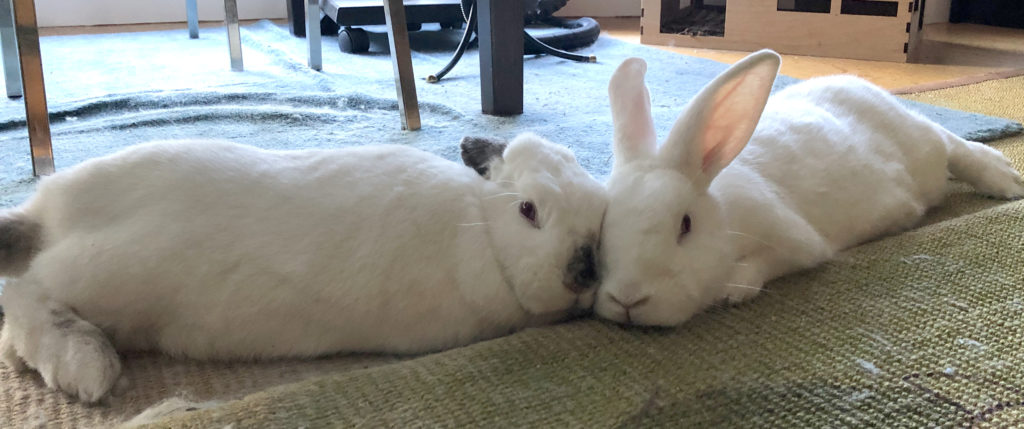
Rabbits as Pets?
Most people don’t get rabbits. I’d wager, recommending a pet rabbit to them is kind of like suggesting they form a relationship with an old sock. They don’t know how and they don’t see the point.
Thirty some years ago, I was clueless myself. I’d waited until after college to enhance my home with a pet, but which kind would be best? A dog didn’t seem practical, because I’d be leaving it alone all day. I was allergic to cats. In a magical moment that literally changed my life, my friend Rebecca said, “Why not get a rabbit?” The only pet rabbits I’d ever heard of were kept in cages in people’s back yards. “No”, she said, “you can litter train them.”
Those five words sent me on a lifelong journey that has always included rabbits. Back then, there was very little information available about pet rabbits. Today we know a lot more, and the information is literally a click away. In spite of that, most people are still right where I was back then.
Why are rabbits still widely viewed as boring fluff balls that do nothing but sit in cages?
Exotic? Livestock? Garden Pest?

It’s no wonder people have a hard time understanding rabbits. The world around us sends lots of mixed signals about what they are.
Most people first see rabbits in their back yard. If they buy or adopt one, they think it’s ok to just let the rabbit go free if things don’t work out. Turns out, those wild rabbits are an entirely different species, (at least in the U.S.; more later) and “freeing” a domesticated rabbit is pretty much a death sentence.
In addition, when we go to the vet, we get told that rabbits are “exotic”. When I think exotic I think of brightly colored birds and of lizards with fins on their backs. Poor bunnies get thrown into the same sorting bin as boa constrictors in the veterinary taxonomy! Why does this classification makes sense to veterinarians? Because, unless a vet goes to the trouble to specialize in exotic animal care, they will graduate from most accredited veterinary schools with pretty much no idea how to treat your rabbit.
On the other hand, the U.S Code Of Federal Regulations explicitly states that rabbits are not exotic. The same Code further obscures the matter by double-classifying rabbits both as “pet animals” and as “farm animals.” Unfortunately, this is still true, putting rabbits in the very strange position of being simultaneously the third most popular pet in the U.S., and a common entree at many American restaurants. (I have often had to explain to wait staff the reason for my involuntary gasp of horror upon opening a menu.)
The Other, Other, White Meat
I think the problem may stem from how rabbits became domesticated. Dogs and cats domesticated themselves for the most part . As predators and scavengers, hanging around human settlements was an advantage for them ’cause there were lots of free eats. Humans probably found it useful to have the dogs around as sentinels or hunting partners, and the cats for reducing vermin, so it was a partnership.
Were rabbits not smart or brave enough to strike up a deal? No, actually they were smart enough not to.
As prey animals, there were no inherent advantages to rabbits in hanging around with people. So when rabbits became domesticated it was by force rather than by choice, to provide the ancient Romans a convenient source of meat , according to researchers at Oxford University.
From the start, keeping rabbits in cages worked well for humans, and seemed like the best way – maybe the only way – to keep these fleet-footed animals with us. The cage became a habit and has remained a standard for rabbits, even after we began to welcome bunnies into our lives as family members instead of food.
Humans seeing rabbits as companions changes the whole game. It creates a situation in which associating with humans has huge advantages for rabbits: reliable food, plus protection from predators and the elements. But since since is a pretty recent development, rabbits have not fully abandoned instinctive predator-avoidance behaviors. Nor have they evolved to read our faces or be attentive to our hand gestures as dogs did. At least, not yet.
So maybe the point of having a pet rabbit is not so obvious. Can a prey animal be as fun a pet as a cat or dog? I say emphatically YES. Here’s what I think it takes.
Let Rabbits Be Rabbits
Start by putting the rabbit on a level playing field with dogs and cats. Would you bring one of those animals home and keep it in a cage most of the time? Fact: A caged rabbit can’t “be a rabbit”. There are a host of things involved in being a bunny that cannot be done in a cage.
1. Running
“All the world will be your enemy, Prince with a Thousand Enemies, and whenever they catch you, they will kill you. But first they must catch you…”
— Lord Frith, the creator of rabbits in Richard Adams’s classic novel Watership Down.
Rabbits were built for speed, like a cheetah. And just like a dog or cat, they really love taking their equipment out for a spin. Here’s our boy, Finnegan, doing what’s affectionately known in rabbit circles as the Bundy 500. Note: this is just a short sample. these can go on for several minutes and often cover a lot more space than this one.
2. Dancing
Behold the binky! Rabbits will do these wild little happy dances if they have a large enough space with good traction like a stable rug. Here is a compilation of binkies performed by a rabbit named Marigold. At the time this was filmed, Marigold was a young rescue rabbit waiting for an adopter to come along. We would regularly visit Marigold, give her some space to move around, and she would put on a show! I’m happy to say Marigold was adopted. I hope her lucky family is enjoying the entertainment daily.
3. Exploring
Rabbits forage for food. That means exploring their surroundings is a hard-wired behavior and very satisfying for a bunny. When in exploration mode our little clowns can be wildly entertaining. We find them doing lots of unusual, adorable things.
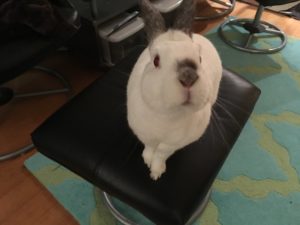

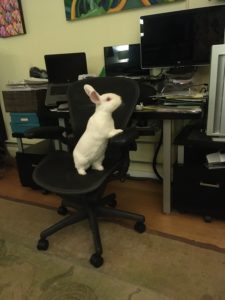
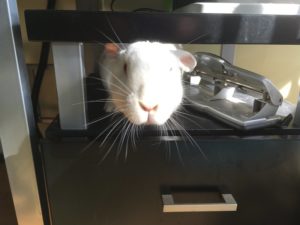
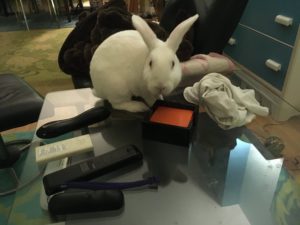
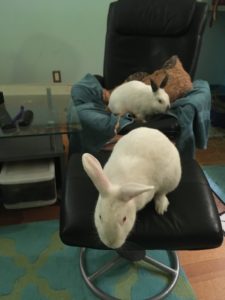
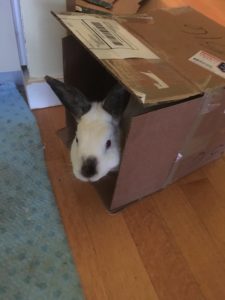
Not everyone is in a situation where they can keep their rabbit free-roaming 24×7, I totally get that. Just keep in mind, being inhibited from performing normal species-specific behaviors places stress on an animal. Just think how sheltering in place for COVID affected your own disposition, mental, and even physical health! The more free-roaming you can make your bunny, the more fun behavior you will get, and the happier and healthier your rabbit will be.
Can We Be Friends?
Domesticated rabbits ain’t yo’ mama’s garden cottontails. The wild rabbits that you see in North America live in found shelter such as bushes and abandoned burrows from other animals, and are solitary except when mating or raising kits. Domesticated breeds are descended from European rabbits, who live in big groups, in tunnels that they dig underground. Rabbit warrens have complex social structures and these groups maintain lifelong relationships. Thus, pet rabbits are looking for someone to love. Yes, we can be friends.
A lot of rabbits are very outgoing and will approach people readily. Our little Moraea is so petting-motivated that I actually initially trained her to touch a target with her nose using pets instead of food treats (If you’re not familiar with target training, see the target training video below). We have to be careful standing up from a chair in our house because so often she has parked herself underneath in hope of getting more pets.
Even a rabbit with a shy personality still needs social interaction. Our big boy, Finnegan, was initially pretty wary of us. We worried that he’d never be a “people” rabbit. But today he’s nearly as outgoing as Moraea, at least with people he knows. In a future blog post I’ll discuss things you can do to increase sociability through positive reinforcement.
One thing is certain, however: what’s not fun for a rabbit is getting picked up. Let’s go back to the whole predator-prey thing. If you are a prey animal, when someone grabs you and holds you, what do you think is about to happen? Nothing good, I assure you! Approaching a rabbit and picking her up is kind of akin to approaching another person while pointing a gun at them. Probably not the best way to make friends!
Now, I know a lot of rabbit owners think it’s fine to pick up their pets and some even believe that their rabbit enjoys it. To them I say: I know you love your bunnies as much as I do. I was firmly in your camp when I got my first rabbit. I could tackle this topic in depth in another blog post. For now, I’ll just say I’ve tried it both ways, and I’m convinced it’s better to pick up pet rabbits as seldom as possible. Soooo…
Don’t Be Scary
To get the most out of your relationship, let your bunny retain control of his body. Instead of picking him up, get down on the floor with him. As with any friend, aim to do things you both enjoy. Almost all rabbits love to be gently stroked on their forehead, ears, and cheeks; most also like their shoulders and backs to be petted. If you’re not convinced, take a look at this video of me petting Moraea right after we have finished a training session. You can see how Moraea melts into the massage, while Finnegan comes over to get some, too! And me, I’m loving every minute of it. One of the best things about it? They are choosing to take part in it.
Let Their Hare Down?
A rabbit who is constantly keeping an eye on his environment for potential threats will typically sleep in a loaf position, with all four legs underneath his body, ready to take flight if needed. They may even sleep with their eyes open!
If a rabbit feels completely comfortable and safe, she is more likely to relax and stretch out. So another advantage you gain by rarely grabbing or picking up your rabbit is you unlock a whole array of lounging behavior. My husband, David, and I have more photos of our bunnies sleeping than any other activity, and that’s because they are so darned cute when they do it. We’re not the only ones who think so. This photo of my love bug Frank (now deceased) has gotten more views than any other photo I have ever posted online: over 65,000 and still counting.
When a flop is a big success
A rabbit who is really ready to chill may perform the flop – a dramatic flip over onto one side for a good nap! It’s hard to capture a flop when it happens so this video starts with Moraea already in a “flopped” position. I just love how her little feet are still up in the air! When she notices you’re watching, a rabbit often de-flops as Moraea does in the video! But notice she trusts me enough that she doesn’t get into a loaf as I approach her. That’s because the vast majority of times I come near her, I either leave her be or gently stroke her head, both of which she is very comfortable with.
Have a Shared Hobby: Training
Rabbits can be trained using positive reinforcement / force-free training. Training can be a shared game that you and your rabbit(s) enjoy together. It’s the best form of communication we have to bridge the gap between humans and other species. Do you have to train your rabbit? No. But it sure makes life a lot more fun for both of you! Here’s a video of my Moraea practicing a simple behavior: targeting to a pointer – that nose touching I mentioned earlier. The target in this case is a yellow ball on a long stick.
So There, That’s the Point.
A rabbit who’s stuck in a cage, spending his days alone may seem boring, but more likely he’s bored, depressed, and possibly also afraid. To get the point of having a rabbit, you have to give him a life that suits him and meet him on his terms. If more people knew this, maybe rabbits wouldn’t be viewed as dull, fearful, or “exotic”.
Are you a rabbit owner? If so, what are the things that make you love living with a rabbit? If you’re not, what questions do you have about owning them? I welcome your comments and look forward to discussing this further!
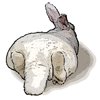 The Fluffy Tail of This Blog Post
The Fluffy Tail of This Blog Post
Rabbits don’t get top billing on the house pet popularity list. It’s also true they have somewhat different needs than dogs and cats. However, the relationship you can have with your pet rabbit can be just as satisfying as a relationship with a dog or cat. Rabbits are social, house trainable, and exhibit tons of lovable behaviors. And you can use positive reinforcement / force-free training techniques to communicate with your rabbit and teach them skills. (More to come about that in future posts!)
**P.S. If Our Carpet is a Mess, Don’t Blame the Bunnies!
I sent a cute photo of Moraea to a friend of mine and her immediate reaction was “Oh my God! Your carpet!”. Oops. So now I actually notice that the videos I’m posting feature floors that would make my mother blanch. Folks, here’s the scoop: how messy a rabbit owner’s floor is depends on two things: how much do they care, and how often are they willing to clean? In our case, sadly, the answer to both questions is, “not nearly enough”. Your mileage will certainly vary.
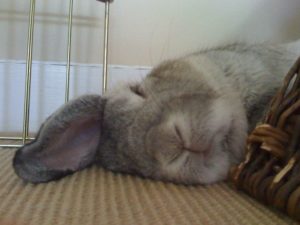
Lauren Patterson says:
This is a brilliant blog! You’re rabbits are adorable and as I read and watched it was such a gift to witness them being rabbits. I have silly questions from a dog centric perspective such as are they able to see the color of the target? Do they have distinct personalities?
Melinda says:
Lauren – thank you for your comment! Rabbits do have different visual abilities than we do. I am no expert but I did read that they don’t see all colors. According to http://www.bio.miami.edu/hare/vision.html they can tell the difference between blue and green. Not sure if they can see yellow or not? But they definitely can see the pointer, because they are able to find it when I move it around.
Rabbits do have distinct personalities! Just as I am sure you have observed with the dogs you have known. Each one of my pet rabbits and those I have rescued has had their own behavior patterns, degree of sociability, social style, and “hobbies”. It has been wonderful fun getting to know each one!
Jean Gray Calandrino says:
Hi Melinda!
Our family has definitely joined the “Bunny Love Club”! Our daughter, Mila, started us on this path in 2013 when she began volunteering at Missouri House Rabbit Society. During her vacations home from college, Mila fostered a beautiful, but rather temperamental bunny named “Peaches” who, we soon realized, was destined to become a member of the family. She adopted Peaches in 2015. Because of the love, attention and care Mila bestowed on her, Peaches soon became a sweet, loving, adorable bunny.
While Mila and Peaches were with us over the Christmas holidays in 2017, Mila convinced Frank and I to foster a chocolate-colored rabbit who had been at the shelter for 2 years. This bunny was so shy and skittish that no one had wanted to adopt her. We were hoping to help her come out of her shell a bit before returning her to the shelter. After a couple of weeks, we realized that we couldn’t bear the thought of this sweet, shy girl possibly spending the rest of her life in the shelter. So she officially joined our family and we named her “Luna”. It took several months before I could approach her enclosure without causing her to panic and bolt into her house to hide. Now Luna greets me every morning, takes food from my hands, lets me pet her while she’s lying down, loves exploring the house and doing binkies. She’s even comfortable with our dog Ollie. However, we suspect that she had had a bad experience with a man because it is only recently that she has begun to get comfortable with Frank despite his patient, gentle, loving overtures toward her.
In February 2020, a pair of bonded, male bunnies were abandoned at the veterinary clinic where Mila was working at the time. She took them home thinking she’d foster them until she could take them to a shelter. Mila soon found out they had some health issues due to an improper diet. Her plan then became to nurse them to health, then take them to the shelter. Due to COVID-19 shutdowns, she had to keep them longer. Of course she fell in love with them, named them “Finn” and “Po” (Star Wars characters) and they became Peaches’ brothers!
So, like yours, the floors of Mila’s apartment and our home definitely wouldn’t pass your mom’s standard of cleanliness! 😉 But that’s ok with us🐰🐰🐰🐰
Melinda says:
Hi Jean! That’s a wonderful family story! You are living proof of how people get hooked on rabbits once they “get” them! I’m so impressed at the progress you have made with Luna. You must be doing things right!